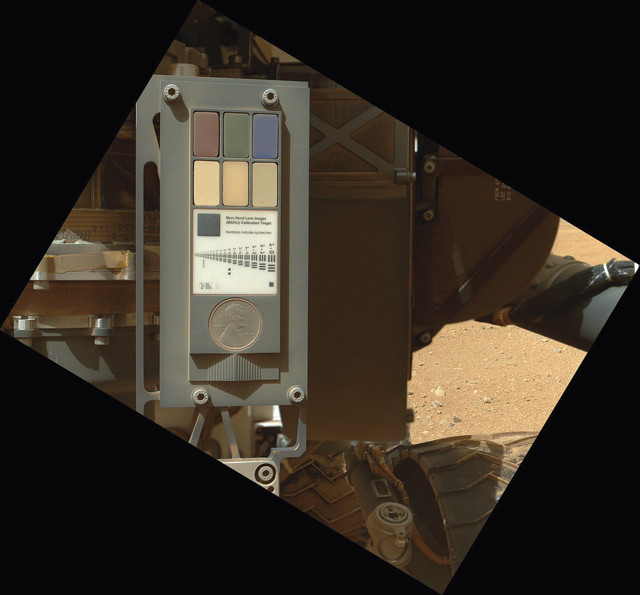
by Sarah Derouin Tuesday, May 1, 2018

A Martian meteorite that landed in Oman will be returned to the Red Planet on the Mars 2020 rover, where it will act as a calibration target, similar to the one shown here aboard the Curiosity rover, which includes color references, a metric bar graphic, a 1909 Lincoln penny and a stairstep-textured pattern for depth calibration. Credit: NASA/JPL-Caltech/Malin Space Science Systems.
With two rovers patrolling the surface of Mars, six spacecraft orbiting above it, and scientists here on Earth studying the Red Planet from afar, new findings are announced often. Here are a few of the latest updates.
Mars is thought by many scientists to have been warm and wet early in its history, before it became the chilly, arid planet we know today. But piecing together the sedimentary evidence of this watery past is an ongoing challenge. In a new study in Planetary and Space Science, Donald Barker of the University of Houston and Janok Bhattacharya of McMaster University in Canada present a new sequence stratigraphy model for an early, wet Mars that involves an active water cycle, including precipitation and runoff. The researchers suggest the Messinian Salinity Crisis (MSC) as a terrestrial analogue, and propose that evaporite, clay and sulfite deposits amid the northern plains of Mars, as well as detrital fans, were progressively produced by the shrinking of an early ocean, resulting from the loss of atmosphere and declining precipitation. “We suggest that the evolution of similar conditions [as the MSC] on Mars would have led to the emplacement of diagnostic sequences of deposits and regional scale unconformities, consistent with intermittent resurfacing of the northern plains and the progressive loss of an early ocean by the end of the Hesperian Era,” the researchers wrote.
A future Mars mission will return a piece of the Red Planet from whence it came. Researchers at NASA’s Jet Propulsion Laboratory in Pasadena, Calif., plan to use a piece of Mars meteorite Sayh al Uhaymir 008, found in Oman in 1999, to calibrate the SHERLOC (Scanning Habitable Environments with Raman and Luminescence for Organics and Chemicals) instrument aboard the Mars 2020 rover mission, which will search for biosignatures and cache rock and soil samples for a later sample return mission. SHERLOC will use a laser that can illuminate rock features as fine as a human hair and analyze rocks for carbon compounds. “We’re studying things on such a fine scale that slight misalignments, caused by changes in temperature or even the rover settling into sand, can require us to correct our aim,” said Luther Beegle, principal investigator for SHERLOC, in a statement. “By studying how the instrument sees a fixed target, we can understand how it will see a piece of the Martian surface.” Other calibration targets will include materials that might be used to outfit humans on future Mars missions, including spacesuit fabric, gloves and a helmet visor, which will allow researchers to test these materials’ performance.
Mars 2020 rover mission planners are considering potential landing sites that have been carved and sandblasted by wind-driven processes. Such processes create and move large sand dunes, and can expose long-buried rock, improving the odds of finding any ancient organic material that the rock might contain. Matthew Chojnacki, of the Lunar and Planetary Laboratory at the University of Arizona, and colleagues used wind measurements collected by previous rover missions to estimate wind erosion at each of eight proposed landing sites, and to determine if newly exposed rock might be present at each. They focused on three criteria: the presence of regional bedforms like dune fields or ripples; the regional sand flux, which they estimated using stereo imagery and digital elevation models to measure sand depths; and evidence of sand movement, determined by mapping geomorphological changes over time. Their results, published in the Journal of Geophysical Research: Planets, suggest the proposed landing sites at Jezero Crater and Northeast Syrtis — two of the three finalist sites announced by NASA in 2017 — offered the best chance for collecting samples of recently exposed rock.
© 2008-2021. All rights reserved. Any copying, redistribution or retransmission of any of the contents of this service without the expressed written permission of the American Geosciences Institute is expressly prohibited. Click here for all copyright requests.